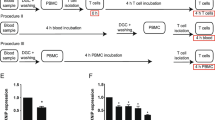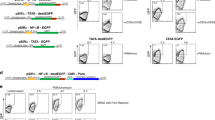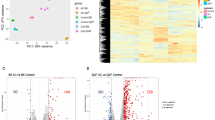Abstract
Chronic granulomatous disease is a primary immunodeficiency, comprising five molecular defects, characterized by an impaired respiratory burst activity of myeloid cells. We are currently developing a gene therapy vector for the p47phox-deficient form of chronic granulomatous disease. Classic intracellular immunostaining of the cytoplasmic p47phox transgene product, however, interferes with respiratory burst activity. In this study we report a new system for measuring p47phox expression: A single open reading frame encoding the surface marker protein ΔLNGFR (truncated low-affinity nerve growth factor receptor) linked to the p47phox transgene by the 2A oligopeptide coexpression technology. Translation generates two discrete products: p47phox localizing to the cytoplasm and ‘ΔLNGFR-2A’ localizing to the cell surface. Six weeks after transplantation of transduced autologous hematopoietic stem cells into p47−/− mice, the intracellular p47phox fluorescence-activated cell sorting (FACS) signal intensities corresponded to surface ΔLNGFR staining in monocytes, B cells, T cells and Sca I+ bone marrow cells in vivo. The p47phox cleavage product restored nicotinamide adenine dinucleotide phosphate–oxidase activity in granulocytes differentiated from transduced p47phox−/− murine hematopoietic stem cells ex vivo, in murine granulocytes/monocytes in vivo, and in transduced human monocyte derived macrophages from p47phox-deficient chronic granulomatous disease patients. In conclusion, this new marker system allows highly efficient, indirect detection of cytoplasmic transgene products by FACS surface staining.
This is a preview of subscription content, access via your institution
Access options
Subscribe to this journal
Receive 12 print issues and online access
$259.00 per year
only $21.58 per issue
Buy this article
- Purchase on Springer Link
- Instant access to full article PDF
Prices may be subject to local taxes which are calculated during checkout



Similar content being viewed by others
References
Curnutte JT, Orkin SH, Dinauer MC . Genetic disorders of phagocyte function. In: The Molecular Basis of Blood Disease. Saunders: London, 1994, pp 493–540.
Roos D, van Bruggen R, Meischl C . Oxidative killing of microbes by neutrophils. Microbes Infect 2003; 5: 1307–1315.
Singh J, Freeling M, Lisch D . A position effect on the heritability of epigenetic silencing. PLoS Genet 2008; 4: e1000216.
Daley JM, Thomay AA, Connolly MD, Reichner JS, Albina JE . Use of Ly6G-specific monoclonal antibody to deplete neutrophils in mice. J Leukoc Biol 2008; 83: 64–70.
Jarrosson-Wuilleme L, Goujon C, Bernaud J, Rigal D, Darlix JL, Cimarelli A . Transduction of nondividing human macrophages with gammaretrovirus-derived vectors. J Virol 2006; 80: 1152–1159.
Halpin C, Cooke SE, Barakate A, El Amrani A, Ryan MD . Self-processing 2A-polyproteins—a system for co-ordinate expression of multiple proteins in transgenic plants. Plant J 1999; 17: 453–459.
Funston GM, Kallioinen SE, de Felipe P, Ryan MD, Iggo RD . Expression of heterologous genes in oncolytic adenoviruses using picornaviral 2A sequences that trigger ribosome skipping. J Gen Virol 2008; 89: 389–396.
Donnelly ML, Gani D, Flint M, Monaghan S, Ryan MD . The cleavage activities of aphthovirus and cardiovirus 2A proteins. J Gen Virol 1997; 78: 13–21.
Donnelly ML, Hughes LE, Luke G, Mendoza H, ten Dam E, Gani D et al. The ‘cleavage’ activities of foot-and-mouth disease virus 2A site-directed mutants and naturally occurring ‘2A-like’ sequences. J Gen Virol 2001; 82: 1027–1041.
Ibrahimi A, Velde GV, Reumers V, Toelen J, Thiry I, Vandeputte C et al. Highly efficient multicistronic lentiviral vectors with peptide 2A sequences. Hum Gene Ther 2009; 20: 845–860.
Chinnasamy D, Milsom MD, Shaffer J, Neuenfeldt J, Shaaban AF, Margison GP et al. Multicistronic lentiviral vectors containing the FMDV 2A cleavage factor demonstrate robust expression of encoded genes at limiting MOI. Virol J 2006; 3: 14.
Lundstrom K . Latest development in viral vectors for gene therapy. Trends Biotechnol 2003; 21: 117–122.
Klump H, Schiedlmeier B, Vogt B, Ryan M, Ostertag W, Baum C . Retroviral vector-mediated expression of HoxB4 in hematopoietic cells using a novel coexpression strategy. Gene Therapy 2001; 8: 811–817.
Ouellet DL, Plante I, Boissonneault V, Ayari C, Provost P . Refractoriness of hepatitis C virus internal ribosome entry site to processing by Dicer in vivo. J Negat Results Biomed 2009; 8: 8.
Li Z, Dullmann J, Schiedlmeier B, Schmidt M, von Kalle C, Meyer J et al. Murine leukemia induced by retroviral gene marking. Science 2002; 296: 497.
Bonini C, Grez M, Traversari C, Ciceri F, Marktel S, Ferrari G et al. Safety of retroviral gene marking with a truncated NGF receptor. Nat Med 2003; 9: 367–369.
Hahn WC, Weinberg RA . Modelling the molecular circuitry of cancer. Nat Rev Cancer 2002; 2: 331–341.
Fehse B, Roeder I . Insertional mutagenesis and clonal dominance: biological and statistical considerations. Gene Therapy 2008; 15: 143–153.
Watanabe-Okochi N, Kitaura J, Ono R, Harada H, Harada Y, Komeno Y et al. AML1 mutations induced MDS and MDS/AML in a mouse BMT model. Blood 2008; 111: 4297–4308.
Recchia A, Bonini C, Magnani Z, Urbinati F, Sartori D, Muraro S et al. Retroviral vector integration deregulates gene expression but has no consequence on the biology and function of transplanted T cells. Proc Natl Acad Sci USA 2006; 103: 1457–1462.
Modlich U, Kustikova OS, Schmidt M, Rudolph C, Meyer J, Li Z et al. Leukemias following retroviral transfer of multidrug resistance 1 (MDR1) are driven by combinatorial insertional mutagenesis. Blood 2005; 105: 4235–4246.
Ott MG, Schmidt M, Schwarzwaelder K, Stein S, Siler U, Koehl U et al. Correction of X-linked chronic granulomatous disease by gene therapy, augmented by insertional activation of MDS1-EVI1, PRDM16 or SETBP1. Nat Med 2006; 12: 401–409.
Acknowledgements
We thank Manuel Grez, Georg Speyer Research Institute, Frankfurt, Germany for the generous gift of vector backbones and helpful discussions. This study was supported by ‘Forschungskredit der Universität Zürich 2005’ and Novartis Stiftung für Medizinisch-Biologische Forschung and Swiss National Science Foundation (Grant no. 320000–121983) to US.
Authorship contribution: VW performed experiments; US, RS and MDR designed the research; US, JR and VW analyzed results and made the figures; US, MDR, RS and JR wrote the paper.
Author information
Authors and Affiliations
Corresponding author
Ethics declarations
Competing interests
The authors declare no conflict of interest.
Additional information
Supplementary Information accompanies the paper on Gene Therapy website
Supplementary information
Rights and permissions
About this article
Cite this article
Wohlgensinger, V., Seger, R., Ryan, M. et al. Signed outside: a surface marker system for transgenic cytoplasmic proteins. Gene Ther 17, 1193–1199 (2010). https://doi.org/10.1038/gt.2010.73
Received:
Revised:
Accepted:
Published:
Issue Date:
DOI: https://doi.org/10.1038/gt.2010.73
Keywords
This article is cited by
-
CRISPR/Cas9-generated p47phox-deficient cell line for Chronic Granulomatous Disease gene therapy vector development
Scientific Reports (2017)
-
Transcytosis in the blood–cerebrospinal fluid barrier of the mouse brain with an engineered receptor/ligand system
Molecular Therapy - Methods & Clinical Development (2015)



